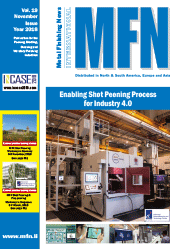E-Archive
Interview
in Vol. 19 - November Issue - Year 2018
Built To Blast
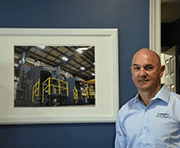
Mike Langtry, President of Langtry Blast Technologies
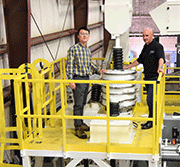
LBTI Design Engineer, Gary Niu discussing media size control in a shot peening machine with Mike Langtry
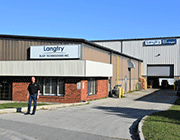
Langtry Blast Technologies, Inc. (LBTI) headquarters and manufacturing facility in Burlington, Ontario (CANADA), 40 Kms from Toronto
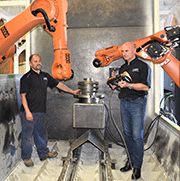
Mike Langtry and Manufacturing Manager, Henry Wiens inspecting a Dual Robot Shot Peening Machine for aircraft engine components including blisks
What makes a company successful and sustainable? As we know, there is no fixed algorithm to predict or determine this. The variables today are more than ever before, and more significantly, global in nature. At MFN, our gauge has been rather simple and very effective. MFN first reported on LBTI in 2014 and then interviewed Mike Langtry, owner and President of Langtry Blast Technologies Inc. (LBTI) in 2015 (MFN Volume 16) when he explained his business philosophy, company goals and general impression of the blast-cleaning and shot-peening industry. LBTI recently celebrated its 15th anniversary and continues to grow stronger with each passing year. MFN’s gauge for success and sustainability was alerted again, and its team visited LBTI in Burlington, Ontario (Canada) this past July and found Mike Langtry mentoring two new millwrights and orienting them into this impactful world of cleaning and peening equipment. Like every successful business owner, Mike too was thrilled to meet with the MFN team and share his experiences of growing the company and expectations for the future.
(?) MFN: Mike, how has the journey been so far?
(!) M. L.: We are very thankful to the industry and owe our success to our customers' faith and trust in our products and services. The last decade has vaulted us into very interesting applications and projects. We’ve managed to not only extend our reach into familiar industries such as Aerospace and Automotive with new applications, but also discovered process interest in new sectors.
We recently delivered multiple, large airblast systems to a well-known aircraft manufacturer bringing us into active consideration for future projects. Our learning curve with projects of such nature though steep, prompted us to equip ourselves without delay. With a large percentage of our business coming from repeat customers, we are aware of the risk of complacency and keep ourselves in regular check to prevent that from happening. Critical customers and big projects of this nature keep us on our toes and remind us of the need to keep re-inventing ourselves in terms of process solutions, cost-effective manufacturing and most importantly, customer service.
LBTI now has an enthusiastic team of engineers and manufacturing professionals that we’re very happy with. I’ll add that the right people can make or be detrimental to the success of a business, and getting the right team together is always a challenge. LBTI is a small, dedicated group of professionals and this is our strength. We thrive on our nimbleness and absence of paradigms and dogma that some of our large competitors hurt from. To this belief, we’ve found it very effective to bring in new talent and train them in our procedures, technology and philosophy.
Our core business values continue to center around customer service. In the last decade, we’ve established several avenues, such as new equipment, technical support, training and retrofits by which to serve our customer base.
(?) MFN: In a market that’s getting crowded and to some extent commoditized, what is your formula?
(!) M. L.: When I decided to establish LBTI after my previous employer shut down, I had the benefit of also knowing what I didn’t want to do! Though paradoxical, it helped me define the vision for LBTI. There is no doubt that the market is flooded with companies that build equipment, both, wheelblast and airblast systems. Our industry is unique wherein the cost of entry isn’t very high. Small companies establish themselves, service and refurbish used machines, and even build new equipment when they hit the proverbial peak of wanting to re-define themselves as a manufacturer. In this process, some of them seem to lose their focus and raison d'être - the customer. This often results in missed deadlines, irate customers and the like. At LBTI, our growth has been exponential, but monitored. We manufacture sophisticated, robotic peening systems in our shop; simultaneously, our dedicated service team will not hesitate to take a call to help a customer by phone or service their 30-year-old baghouse that’s preventing them from running their production lines. Our growth will never be at the cost of a dis-satisfied customer or an incomplete installation. This is what differentiates us from the ‘crowd’ and keeps our offerings from being commoditized.
As you can appreciate, blast equipment demands regular maintenance. LBTI has customers near its Burlington plant as well as in far-flung locations such as South Africa and China. We continue to visit such customers semi-annually or as required for service and learn from each interaction to regularly re-design equipment and make them serviceable by customer’s local crews. For existing equipment, we regularly update them with our latest improvements. Equipment could be maintenance-prone, but that shouldn’t stop a manufacturer from improving its maintainability. LBTI does not have the luxury of a separate engineering department that only looks after modernization of equipment, but this lack of luxury also ensures that the same group of engineers remember the modernization design initiative when designing our next new machine. It doesn’t get lost in transfer between different departments, which is something we see all the time with our larger-size competitors.
Another initiative that keeps us competitive in this environment is training. With LBTI, we don’t believe in keeping anything enigmatic or secretive when it comes to technology dissemination with our customers. We liberally share information that’ll be useful for them to better use their equipment and process. We regularly train them on upgrades and extend our training for new equipment from the cursory ‘one-week at site’ to regular refreshers.
The choice of allowing a business to be commoditized in a crowded environment rests with the team that operates the business. Blast cleaning and shot peening technologies continue to grow and the opportunities are tremendous.
(?) MFN: What are some of the innovations you have brought to the industry?
(!) M. L.: We have made technology affordable to our users. Our industry has only scratched the surface in taking advantage of automation, robotics and controls. We continue to demonstrate to our customers that they too can benefit from the repeatability, accuracy and process-monitoring benefits of this technology. At the same time, we try to not over-complicate the process and equipment. For instance, when not required, which is in most cases, we don’t push CNC technology on our customers. Whenever possible, we use standard automation such as robots for part and nozzle movements. Some of the product and service innovations I’d like to emphasize here are:
All shot-peening applications require media drop tests to be conducted for each blast wheel or nozzle. For wheelblast machines, we have developed a unique drop test arrangement using a shuttle module with diverter gates. This arrangement is designed to work with multiple wheels and can automatically divert media from the outlet of the storage hopper to either the blast wheel or media drop test bin.
Our rotary nozzle lance arrangement continues to be a very popular retrofit to existing nozzle peening and grit blasting machines. We have developed a cost-effective rotary lance arrangement to process holes and slots, complete with closed feedback loop to detect and monitor rotary motion.
We have revolutionized the use of slewing rings for different parts of the peening and grit blasting process, starting from conventional use in rotary tables to work cars, nozzle carriage tilt mechanisms and accurate positioning devices in part handling. Slewing rings are very effective in carrying (and positioning) eccentric loads, which are commonly encountered when processing large aerospace components such as landing gear.
Innovations are not restricted to new products alone. We have worked with customers on retrofitting nozzle carriages and robots to their existing manual blast rooms and even wheelblast machines. This has helped them curtail their audit requirements to a single machine rather than two distinct machines.
(?) MFN: How does LBTI interact with the other equipment manufacturers in the industry?
(!) M. L.: When we first started, we used to private-label wheel and airblast equipment for a large equipment manufacturer. We continue to service such machines whenever called upon. Though the aspect of competition is evident with manufacturers the same size as LBTI, that’s not the case with larger companies. We occasionally get called upon to jointly work on a project with a larger company on specific aspects that they value our strengths to be in.
We share a cordial relationship with all equipment manufacturers without any exceptions. When servicing their machines, this relationship is critical to ensure that the end-user ultimately benefits from the best solution.
(?) MFN: What do you think the future has in store for this industry?
(!) M. L.: New opportunities, in terms of customers and projects are being presented regularly. We are noticing sophisticated controls being used in new as well as retrofitted existing machines, as is robotics. The next possible evolutionary step is Industry 4.0 or the new manufacturing revolution that we keep hearing about. Though being talked about extensively, I have my own interpretation of how this is going to shape our industry. This new development isn’t that new if you think about it. Well-designed machine controls always had the ability to gather and transfer information to a centralized system or a downstream process. What’s more important is the next activity, in other words – what are we going to do with this information? The future of this industry will rest on some of the following aspects:
Machine intuition: The ability of the controls system to predict (not just identify) failure of components. For example, the failure of a hanger bearing in an auger, if predicted, could prevent significant production downtime.
Increased traceability: Though we already address this requirement with our Aerospace customers, it will likely spread to a wider customer base as process traceability surrounding a component becomes important. As our customers explore the use of advanced materials (composites, new aluminum alloys etc.), parts tend to get multi-functional and complex in design. Such parts undergo multiple stages of processing and will require monitoring throughout the production process, including in a shot peening or grit blasting machine.
Build and operate: Companies might consider a shift from equipment ownership to paying for parts produced. Like a wet-lease for an aircraft, this could open opportunities for companies to build and supply a machine with the operator working at the customer’s site.
(?) MFN: What does the future have in store for LBTI?
(!) M. L.: LBTI exists to service the needs of its customers. We have followed customers to their global locations and continue to satisfy their thirst for technology. Our goal is to continue being a ‘complete solutions provider’ to some of our existing and valued Aerospace customers. At this point, our focus is on peening and cleaning equipment. We’re in the process of expanding this to other facets of our industry such as vibratory finishing and metal-additive technologies. For this, we plan to partner with reputed industry names and capitalize on our existing relationships with Aerospace end-users and extend our offering to them.
Another ongoing initiative with our controls engineers is the development of a simple HMI platform that will be standard throughout our line of equipment. This platform will consider the needs of Industry 4.0 yet make the experience as simple as possible to the operator. We also plan to incorporate several maintenance-related upgrades such as the system prompting operator attention to specific maintenance actions based on anticipated wear/failure. Suppliers have always maintained that such controls come with a correspondingly high cost. We’re out to disprove that and make it affordable to incorporate into the simplest of machines.
LBTI is a small but effective solution to a customer’s custom and standard application needs. We want to capitalize on this as we evolve into LBTI 2.0! During a recent interaction, one of our customers remarked that working with us was very refreshing and that the quality and speed of our response couldn’t be matched by competitors. We’d like to maintain this aspect of LBTI and keep earning such feedback. We’re ISO-certified, and our documentation process is neither elaborate nor cumbersome. We believe in quick resolution to customer issues, whether it be design-, manufacturing- or sitework-related. Typically, minor issues are sorted out through a quick meeting or joint phone call. We do not believe in shortchanging the customer or ‘nickel and diming’ them even if it amounts to us taking the charge due to a missed costing situation.
(?) MFN: What message would you like to send out to the industry?
(!) M. L.: At LBTI, we’ve taken it upon ourselves to develop the workforce of the future for our products and services. We notice that the skills gap caused by retirement of experienced personnel is widening rather fast. Our request to our competitors is that they develop initiatives to nurture new talent and prevent our industry from being taken over by a larger, complimentary product. I’ve met some amazing people within our industry and I am sure they can mentor young professionals and keep their interest alive to pursue a future within the industry.
My request to MFN is to continue publicising the wonderful work different companies are doing within the industry to further its cause.
MFN would like to thank Mike Langtry for this interview.
For Information:
Langtry Blast Technologies Inc
5390 Munro Court, Burlington
Ontario, L7L 5N8, Canada
Tel. +1.905.681 2030, Fax +1.905.681 2814
E-mail: info@blastech.org
www.blastech.org



